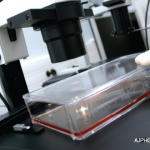Other mimics are the muscular dystrophies, a diverse group of inherited disorders of muscle sarcolemmal proteins with dystrophic changes seen on muscle biopsy, usually marked by progressive muscle weakness. The gold standard for diagnosis is identifying the genetic defect.
Energy Source for Muscle Metabolism
Then, Dr. O’Rourke said, there are metabolic myopathies, and to properly identify and treat these, clinicians need to understand how muscles get their energy.
“You have to have some basic understanding of the biochemistry in order to ask the right clinical questions, as well as to order the right testing to get to the right answer,” he said.
He used the analogy of a hybrid car, with its starter motor for cold starts; gas engine for rapid, mass acceleration but its problems of inefficiency, limited energy capacity and pollution; electric motor for cruising and idling, which is efficient but has limited immediate power; and the transmission, which integrates the power from both of those engines to get the wheels to turn.
When you first contract a muscle, there is a creatinine kinase (CK) reaction, which produces a very limited amount of stored ATP. This is like the muscle’s starter motor.
“The CK reaction allows you a few extra seconds to create additional ATP to get things going before glycolysis takes over,” Dr. O’Rourke said.
And instead of gasoline, there’s glycogen, which is limited and pollutes, in the absence of sufficient oxygen, in the form of lactic acid. Through glycolysis, glucose is converted into pyruvate, which in the presence of adequate oxygenation is then further metabolized in the Krebs cycle.
The transmission is the electronic transport chain (ETC) that leads to the production of ATP. And the electric motor is essentially the oxidation of fats into pieces that can be used by the ETC to make ATP.
Diagnostic Approach
Dr. O’Rourke suggested two pattern-recognition stages that can be helpful in getting to a diagnosis.
In the first, clinicians should ask a series of questions about symptoms, how long symptoms last, family history, what brings about the muscle fatigue, whether there are associated systemic problems and how the weakness is distributed.
In metabolic myopathies, weakness typically stems from exertion or an infection or from eating or fasting, and is episodic. Because the majority of these diseases are mainly autosomal recessive, there may be no known family history.
The other recognition stage, he said, is assessing for changes on either side of the clog or metabolic block. In these disorders, because there is a breakdown in metabolic processing, levels of whatever is not being processed properly should be higher than normal on one side of the clog, and the product of that process should be lower than normal on the other.

